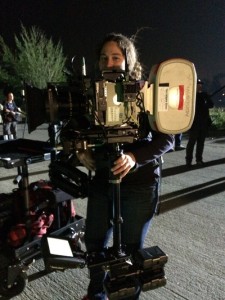My First ‘Oner’

Lopez with Steadicam rig
Steadicam operator and Local 600 member Jessica Lopez talked with us about her work with Steadicam rigs. Lopez takes pride in what she does. “One of the best experiences on set was shooting my first ‘oner’. It was an eight-minute shot that took place in a one-story house. It involved a wife coming home catching her husband wearing her lipstick.
“The shot mainly followed the wife as she scuffled through the house curious, confused, and upset. There were some great moments where I would whip pan over to the husband to catch his reactions before the wife would be re-introduced to the shot.”
Lopez says shot rehearsal is critical. “It took us a day and a half of non-stop rehearsals to nail down all the acting key points and all the Steadicam moves. Even today it is still one of my proudest jobs because of the challenge and the praise I received from the cast and crew.
“It’s a great feeling when everyone is at video village watching and cheering you on for your hard work.”
Camera and Rig Choices
With the many camera options available, we asked Lopez how she maintains familiarity with them all. “Honestly, I believe the First AC (Assistant Camera) is the one required to maintain more familiarity with any camera than an operator. I consider myself a ‘frame watcher’. I understand camera functions, features, navigating menus, etc. But I make sure to refer to assistants that have an encyclopedia of various cameras filed in their minds. I care mostly about the user-friendly features, the mass, and accessories. Just give me the camera and I will keep them in the frame compositionally and aesthetically.
“Oh, and the Sony F55 is my favorite camera to work with currently.”
Career Path

Lopez on location
Lopez’s path to becoming a Steadicam operator was the opposite of most. “Ha, I think I am one of the few that actually started backwards,” says Lopez. “I started off in Steadicam, then moved into cameras. I know, weird. Most guys start off in the industry as grips and assistants before moving into Steadicam. Not me, I went straight to the source.
“Out of college I was fortunate enough to start working for Tiffen Steadicam. Learning the anatomy, assembly, and packing of a rig was the best knowledge I had ever received. Even dealing with customers taught me so much. Guys would bring rigs in from sets around the world. It was so exciting getting to meet a lot of the veteran operators out there.
“After my time at Tiffen Steadicam was done, I was so fortunate to get a job at Panavision Hollywood. There I started to learn about cameras, accessories, and how the camera department functioned at camera rental houses. Oh man, what a great job. It was like film school but you not only got paid, you learned from working professionals daily. There are several people I still work with today that I met during my time at Tiffen and Panavision.”
Lopez’s advice: “It is essential to try to get work at camera houses when you first start off in a camera operating career. I mean, seven years ago I knew nothing. Today I am so proud of myself for having the guts to stick around and follow my dreams. I didn’t start off an operator but I was an active Steadicam Guild member and Associate SOC (Society of Camera Operators) member while I patiently saved money to get my own Steadicam rig.”
Women Steadicam Operators
A woman Steadicam operator is relatively rare. We wondered what’s that like. Do you have to go further to prove yourself? “Hmm, being a female Steadicam operator has its ups and downs,” Lopez says. “Yes, I am in a small group, which is excellent. I love being part of that small group. I grew up an Army brat, with mechanics and sports. So I feel most comfortable in a female-challenging role in a male-dominated profession.

On location
“The worst part about it,” she says, “is I get overlooked a lot. Say someone hands a producer a list of Steadicam operators and on there my name is third on the list, saying ‘Jessica Lopez’, among Bob, Joe, Jimmy, Larry, etc. Because it’s a feminine name, automatically I get passed on the list. Why? Because I’m a woman, I can’t carry a rig, I can’t be that good?
“There are six-feet tall, big, muscular men that I sometimes get called to come in and replace. Why? Hmmm, let’s see. First I hear about their attitudes and how they won’t listen or won’t fly an extra three pounds on their sled.
“Second, I hear about how they just couldn’t do the shot. Like their brains couldn’t tell their body how to twist around a small bar opening, follow the server’s tray, leave the tray and focus on a group at a nearby table, while perfectly timing your return back onto the server as she lands at her destination, allowing a small push in onto a main character.”
Importance of Mentors
“So yes, I have to prove myself time after time,” Lopez says. “Mainly I’m not seeking approval of others in order to be a good operator. I seek feedback, support, and guidance.
“The most supportive people in my life besides my family are my mentors. Some people have one mentor, I have five. All seasoned Steadicam operators that have been doing Steadicam for decades that want to see me push through and be one of the best. They are my lifeline.
“They have taught me the most – from shadowing them on set, to hanging in their garages going through gear, to having a nice lunch and talking about their set horror stories. Now that I am finally in Local 600, they are starting to pass me work because they know I will bust my butt and represent them well.”
See Jessica Lopez’s film reels and resumé.
